
A Fabergé egg is a jewelled egg created by the jewellery firm House of Fabergé, in Saint Petersburg, Russia. As many as 69 were created, of which 57 survive today. Virtually all were manufactured under the supervision of Peter Carl Fabergé between 1885 and 1917. The most famous are his 52 "Imperial" eggs, 46 of which survive, made for the Russian emperors Alexander III and Nicholas II as Easter gifts for their wives and mothers. Fabergé eggs are worth millions of dollars and have become symbols of opulence.

The Imperial Coronation egg is a jewelled Fabergé egg made under the supervision of the Russian jeweller Peter Carl Fabergé in 1897 by Fabergé ateliers, Mikhail Perkhin and Henrik Wigstrom. The egg was made to commemorate Tsarina, Empress Alexandra Fyodorovna.

The House of Fabergé was a jewellery firm founded in 1842 in Saint Petersburg, Russia, by Gustav Faberge, using the accented name Fabergé. Gustav's sons – Peter Carl and Agathon – and grandsons followed him in running the business until it was nationalised by the Bolsheviks in 1918. The firm was famous for designing elaborate jewel-encrusted Fabergé eggs for the Russian Tsars, and for a range of other work of high quality and intricate detail. In 1924, Peter Carl's sons Alexander and Eugène Fabergé opened a firm called Fabergé & Cie in Paris, France, making similar jewellery items and adding the name of the city to their firm's stamp, styling it FABERGÉ, PARIS.

The Twelve Monograms egg, also known as the Alexander III Portraits egg, is an Easter egg made under the supervision of the Russian jeweller Peter Carl Fabergé in 1896 for Tsar Nicholas II of Russia. It was presented by Nicholas II to his mother, the Dowager Empress Maria Feodorovna. The egg was the second Fabergé egg ever given by Nicholas II to his mother as an Easter present.

The Lilies of the Valley egg is a jewelled Fabergé egg made under the supervision of the Russian jeweller Peter Carl Fabergé in 1898 by Fabergé ateliers. The supervising goldsmith was Michael Perchin. The egg is one of the three eggs in the Art Nouveau style. It was presented on April 5 to Tsar Nicholas II, who gave it as a gift to his wife, the Tsarina, Empress Alexandra Fyodorovna. The egg is part of the Victor Vekselberg Collection, owned by The Link of Times Foundation and housed in the Fabergé Museum in Saint Petersburg, Russia.
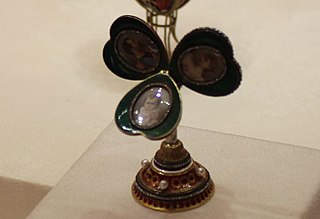
The Mauve egg is a jewelled Easter egg made under the supervision of the Russian jeweller Peter Carl Fabergé in 1897, for Nicholas II of Russia, who presented it to his mother, the Dowager Empress Maria Feodorovna on April 18, 1897.

The Empire Nephrite egg is a jewelled Easter egg, purported to be one of the Imperial Eggs made under the supervision of the Russian jeweller Peter Carl Fabergé in 1901–1902 for Nicholas II of Russia, who presented it to his mother, the Dowager Empress Maria Feodorovna, at Easter 1902. This provenance has been challenged by some Fabergé experts.

The Bay Tree egg is a jewelled nephrite and enameled Fabergé egg made under the supervision of the Russian jeweller Peter Carl Fabergé in 1911, for Nicholas II of Russia who presented the egg to his mother, the Dowager Empress Maria Feodorovna, on 12 April 1911.
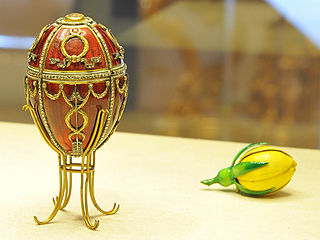
The Rosebud egg is a jewelled enameled Easter egg made by Michael Perchin under the supervision of the Russian jeweller Peter Carl Fabergé in 1895, for Nicholas II of Russia, who presented the egg to his wife, Empress Alexandra Feodorovna. It was the first Fabergé egg that Nicholas presented to Alexandra.

The Duchess of Marlborough egg, also known as the Pink Serpent egg, is a jewelled enameled Easter egg made by Michael Perchin under the supervision of the Russian jeweller Peter Carl Fabergé in 1902.
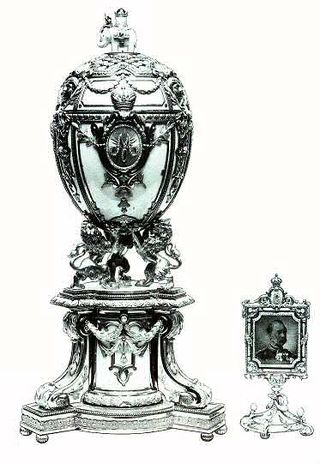
The Royal Danish egg is a jewelled enameled Easter egg made under the supervision of the Russian jeweller Peter Carl Fabergé in 1903, for Nicholas II of Russia, who presented the egg to his mother, the Dowager Empress Maria Feodorovna. One of six Fabergé eggs that are currently lost, it is one of two eggs whose existence is known only from a single photograph, the other being 1909's Alexander III Commemorative egg. A partially obscured photograph of the lost 1888 egg Cherub with Chariot may also exist.
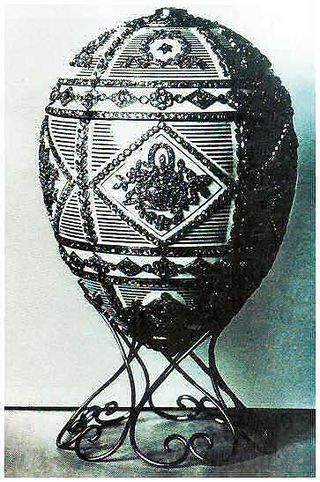
The Alexander III Commemorative egg is a jewelled enameled Easter egg made under the supervision of the Russian jeweller Peter Carl Fabergé in 1909, for Nicholas II of Russia, who presented it to his mother, the Dowager Empress Maria Feodorovna.

The Gatchina Palace egg is a jewelled, enameled Easter egg made under the supervision of the Russian jeweler Peter Carl Fabergé in 1901, for Nicholas II of Russia. Nicholas II presented it to his mother, the Dowager Empress Maria Feodorovna, at Easter in 1901. The egg opens to reveal a surprise miniature gold replica of the Gatchina Palace that was built for Count Grigory Orlov and was later acquired by Tsar Paul I. It is one of two Imperial Easter eggs in the collection of the Walters Art Museum in Baltimore, Maryland.

The Red Cross with Imperial portraits egg is a jewelled and enameled Easter egg made by Henrik Wigström (1862–1923) under the supervision of the Russian jeweller Peter Carl Fabergé in 1915, for Nicholas II of Russia, who presented the Fabergé egg to his mother, the Dowager Empress Maria Feodorovna, in the same year.

The Caucasus Egg is a jewelled enameled Easter egg made by Michael Perkhin under the supervision of the Russian jeweller Peter Carl Fabergé in 1893. The Fabergé egg was made for Alexander III of Russia, who presented it to his wife, Empress Maria Feodorovna.

The Rock Crystal egg or Revolving Miniatures egg is an Imperial Fabergé egg, one in a series of fifty-two jeweled eggs made under the supervision of Peter Carl Fabergé for the Russian Imperial family. It was created in 1896 for Empress Alexandra Feodorovna. The egg currently resides in the Virginia Museum of Fine Arts.

The Swan egg is a Fabergé egg, one in a series of fifty-two jewelled eggs made under the supervision of Peter Carl Fabergé. Commissioned in 1906 by Tsar Nicholas II, the egg was presented to the Dowager Empress Maria Feodorovna on Easter that year for her 40th wedding anniversary.

The Dowager Fabergé egg, is a jewelled Easter egg made under the supervision of the Russian jeweller Peter Carl Fabergé in 1898. The egg was made for Nicholas II of Russia, who presented it to his mother, the Dowager Empress Maria Feodorovna on Easter 1898.
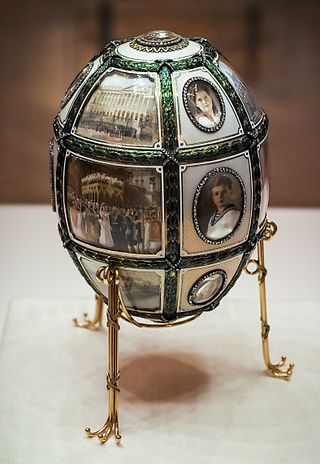
The Fifteenth Anniversary Egg is an Imperial Fabergé egg, one of a series of fifty-two jewelled enameled Easter eggs made under the supervision of Peter Carl Fabergé for the Russian Imperial family.



















